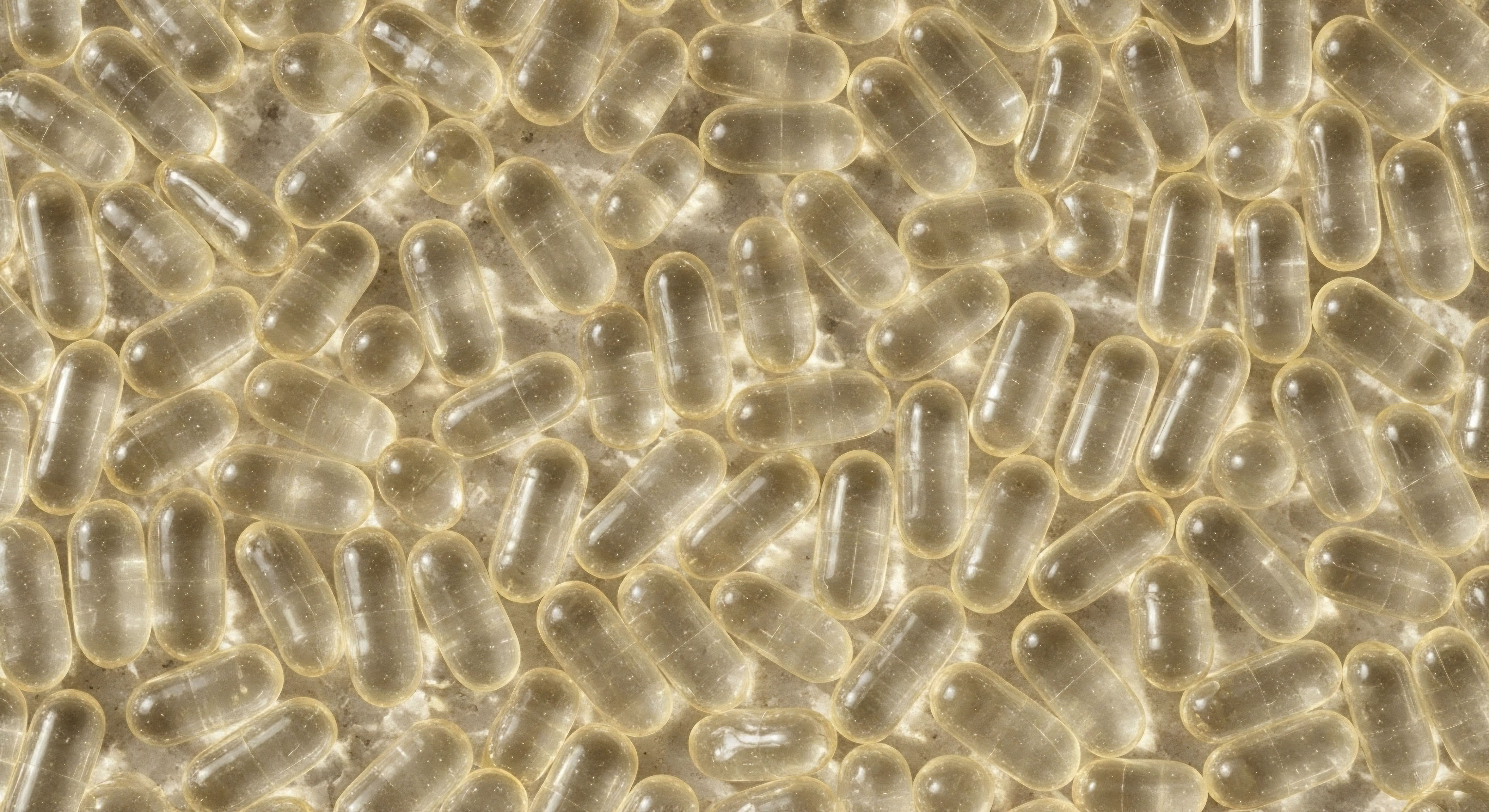

Fundamentals
When you experience shifts in your well-being ∞ perhaps a persistent fatigue that defies rest, unexpected changes in mood, or a recalibration of your body’s usual rhythms ∞ it often prompts a deep introspection. These sensations are not merely fleeting discomforts; they are often the body’s intricate signaling system communicating an imbalance.
Your endocrine system, a sophisticated network of glands and hormones, orchestrates nearly every physiological process, from energy regulation and sleep cycles to emotional stability and reproductive vitality. When this delicate orchestration falters, the impact can be profound, affecting your daily experience and long-term health trajectory.
Understanding the origins of these internal signals becomes paramount. In a world where health solutions are increasingly sought, the integrity of what we introduce into our biological systems holds immense significance. Just as a skilled conductor ensures each instrument plays its precise part, your body relies on accurate biochemical messengers.
The introduction of unverified or improperly manufactured pharmaceutical products can introduce dissonance into this finely tuned biological symphony, leading to unpredictable and potentially harmful effects on your hormonal health and metabolic function.
Recognizing your body’s signals is the first step toward understanding the intricate balance of your endocrine system.
The foundational principle in safeguarding your physiological equilibrium involves a clear understanding of the substances interacting with your internal chemistry. Legitimate pharmaceutical compounds undergo rigorous testing and quality control to ensure their identity, purity, potency, and safety. This meticulous process provides a degree of assurance that the intended therapeutic effect will be achieved without introducing unforeseen complications.
In stark contrast, illicit pharmaceutical products bypass these critical safeguards, presenting a significant hazard to anyone consuming them. Their composition is unknown, their dosage inconsistent, and their potential for contamination or adulteration is high.
Consider the profound impact of substances that mimic or interfere with your natural hormonal pathways. A counterfeit testosterone preparation, for instance, might contain an entirely different steroid, an incorrect dosage, or harmful contaminants.
Such a substance could not only fail to address a genuine hormonal deficiency but could also introduce new, adverse effects, further disrupting the delicate hypothalamic-pituitary-gonadal (HPG) axis. This axis represents a central command center for hormonal regulation, and its disruption can cascade into widespread systemic issues.

Why Identify Unverified Substances?
The drive to identify unverified pharmaceutical products stems from a fundamental need to protect public health and individual well-being. When individuals seek to optimize their hormonal health or address specific metabolic concerns, they rely on the integrity of the therapeutic agents they use.
The presence of counterfeit or substandard medications poses a direct threat, as these products often contain incorrect active ingredients, insufficient or excessive dosages, or even toxic contaminants. Such variations can lead to treatment failures, severe adverse reactions, or the masking of underlying health issues.
A precise identification process ensures that what is labeled as a specific hormone or peptide truly contains that compound in the correct concentration. This analytical rigor provides the necessary confidence for both clinicians and individuals pursuing personalized wellness protocols. Without reliable methods for detecting these illicit substances, the pursuit of vitality becomes a precarious endeavor, fraught with uncertainty and potential harm.
Accurate identification of pharmaceutical products is essential for protecting health and ensuring therapeutic integrity.

The Chemical Fingerprint of Authenticity
Every chemical compound possesses a unique set of physical and chemical properties, much like a distinct fingerprint. These properties allow scientists to identify and quantify substances with remarkable precision. For pharmaceutical products, this involves verifying the molecular structure of the active pharmaceutical ingredient (API), confirming its purity, and ensuring the absence of unintended byproducts or contaminants. This process is not merely an academic exercise; it forms the bedrock of pharmaceutical quality assurance.
The fundamental methods for detecting illicit pharmaceutical products rely on exploiting these unique chemical signatures. They involve techniques that can separate components of a mixture, identify individual compounds based on their interaction with light or energy, and determine their exact molecular weight. These initial steps lay the groundwork for more sophisticated analyses, allowing for a systematic approach to verifying the authenticity and safety of any given substance.


Intermediate
The pursuit of hormonal balance and metabolic optimization often involves precise therapeutic interventions. For individuals considering protocols such as Testosterone Replacement Therapy (TRT) or Growth Hormone Peptide Therapy, the exact composition and purity of the administered compounds are not just desirable; they are absolutely critical for safety and efficacy.
The methods employed to detect illicit pharmaceutical products are extensions of the same analytical principles used in quality control for legitimate medications, ensuring that what enters your system is precisely what is intended.
Imagine your body’s endocrine system as a highly sensitive communication network, where hormones are specific messages delivered to precise receptors. An authentic pharmaceutical product delivers the correct message, enabling the desired physiological response. An illicit product, however, might deliver a garbled message, a different message entirely, or even a toxic one, disrupting the entire communication flow. The analytical techniques used to identify these problematic substances function as sophisticated decoders, revealing the true nature of the chemical message.

What Analytical Techniques Identify Illicit Products?
Several powerful analytical techniques serve as the frontline defense against illicit pharmaceutical products. These methods allow chemists to separate complex mixtures, identify individual components, and quantify their concentrations. They provide the empirical data necessary to distinguish between a genuine therapeutic agent and a potentially harmful counterfeit.
- Spectroscopy ∞ This broad category of techniques examines the interaction of matter with electromagnetic radiation. Different compounds absorb, transmit, or reflect light in unique ways, creating a distinctive “spectral fingerprint.”
- Chromatography ∞ These methods separate components of a mixture based on their differential distribution between a stationary phase and a mobile phase. This separation is a crucial preliminary step for identifying individual compounds.
- Mass Spectrometry ∞ This technique measures the mass-to-charge ratio of ions, providing highly specific information about the molecular weight and structure of compounds.

Infrared and Ultraviolet-Visible Spectroscopy
Infrared (IR) spectroscopy provides information about the functional groups present within a molecule. When IR light passes through a sample, specific bonds within the molecules vibrate at characteristic frequencies, absorbing energy at those wavelengths. The resulting spectrum, a plot of absorbance versus wavelength, is unique for each compound. This makes IR spectroscopy a valuable tool for rapid identification, particularly for verifying the identity of a known substance or detecting the presence of unexpected functional groups that might indicate adulteration.
Ultraviolet-Visible (UV-Vis) spectroscopy measures the absorption of light in the ultraviolet and visible regions of the electromagnetic spectrum. Many pharmaceutical compounds, especially those with conjugated double bonds or aromatic rings, absorb UV-Vis light at specific wavelengths. The intensity of this absorption is directly proportional to the concentration of the substance, allowing for quantitative analysis. This method is often used for purity checks and concentration determinations of active ingredients.
Spectroscopic methods provide unique chemical fingerprints for identifying and quantifying pharmaceutical compounds.
Consider a scenario where a patient is prescribed Testosterone Cypionate for low testosterone. A legitimate product will exhibit a specific IR spectrum corresponding to the testosterone molecule and its cypionate ester, along with a characteristic UV-Vis absorption profile. An illicit product might show a different IR spectrum, indicating an incorrect compound, or an altered UV-Vis profile, suggesting impurities or an incorrect concentration.

Chromatographic Separation Techniques
Before a compound can be definitively identified, it often needs to be separated from other substances in a mixture. This is where chromatographic techniques excel.
High-Performance Liquid Chromatography (HPLC) is a widely used technique for separating, identifying, and quantifying components in a liquid mixture. A liquid sample is injected into a column packed with a stationary phase. A liquid mobile phase then carries the sample through the column.
Different components interact differently with the stationary phase, causing them to travel at different speeds and separate from each other. The separated components are then detected as they exit the column. HPLC is particularly effective for non-volatile or thermally unstable compounds, making it ideal for many hormonal preparations and peptides.
For instance, in analyzing a sample of Sermorelin, an HPLC system can separate Sermorelin from any degradation products, impurities, or other peptides that might be present. The retention time (the time it takes for a compound to pass through the column) and the peak area (indicating concentration) provide critical information about the sample’s purity and potency.
Gas Chromatography-Mass Spectrometry (GC-MS) combines the separating power of gas chromatography with the identification capabilities of mass spectrometry. In GC, a sample is vaporized and carried by an inert gas through a column. Components separate based on their boiling points and interactions with the column.
As each separated component exits the GC column, it enters the mass spectrometer, which then ionizes the molecules and measures their mass-to-charge ratio. This tandem approach provides both separation and highly specific identification. GC-MS is particularly useful for volatile or semi-volatile compounds, often requiring derivatization for less volatile substances like steroids.
The table below illustrates the primary applications of these chromatographic methods in pharmaceutical analysis ∞
| Method | Primary Application | Typical Compounds Analyzed |
|---|---|---|
| HPLC | Separation and quantification of non-volatile or thermally unstable compounds. | Peptides (e.g. Ipamorelin, CJC-1295), most hormones (e.g. Testosterone, Progesterone), large molecules. |
| GC-MS | Separation and identification of volatile or semi-volatile compounds. | Steroids (e.g. Testosterone, Anastrozole), some smaller peptides after derivatization, volatile impurities. |

The Role of Mass Spectrometry
Mass spectrometry stands as a cornerstone in the definitive identification of pharmaceutical compounds. After a compound is separated (often by chromatography), it is introduced into the mass spectrometer, where it is ionized and fragmented. The instrument then measures the mass-to-charge ratio of these ions and their fragments. This process generates a unique “mass spectrum” that serves as a molecular fingerprint. By comparing this spectrum to libraries of known compounds, scientists can unequivocally identify the substance.
For instance, if a sample purporting to be PT-141 (Bremelanotide) is analyzed, mass spectrometry can confirm its exact molecular weight and fragmentation pattern, verifying its identity. If the spectrum shows a different molecular weight or fragmentation pattern, it immediately signals that the product is not PT-141, or contains significant impurities. This level of precision is vital when dealing with compounds that have specific biological activities, such as those used in sexual health protocols.
Mass spectrometry provides definitive molecular identification, crucial for verifying pharmaceutical authenticity.
These analytical methods, when applied systematically, create a robust framework for detecting illicit pharmaceutical products. They allow for the verification of active ingredients, the detection of contaminants, and the assessment of dosage accuracy, all of which are paramount for individuals seeking to optimize their health through targeted biochemical recalibration. The precision of these techniques mirrors the precision required in managing the body’s delicate hormonal systems.


Academic
The detection of illicit pharmaceutical products, particularly those impacting hormonal and metabolic systems, represents a sophisticated analytical challenge. This endeavor moves beyond simple identification, delving into the intricate realm of quantitative analysis, impurity profiling, and the detection of novel or masked compounds.
The precision required in this field mirrors the exacting demands of endocrinology itself, where minute changes in hormone concentrations can elicit significant physiological responses. Understanding these advanced methodologies provides a deeper appreciation for the scientific rigor underpinning safe and effective personalized wellness protocols.
The endocrine system operates through complex feedback loops, where the concentration of one hormone can directly influence the production or activity of another. For example, the administration of exogenous testosterone, as in Testosterone Replacement Therapy (TRT), can suppress endogenous testosterone production via negative feedback on the hypothalamic-pituitary-gonadal (HPG) axis.
The introduction of an unverified or adulterated product can disrupt these delicate regulatory mechanisms in unpredictable ways, making precise analytical detection not merely a quality control measure, but a critical safeguard for systemic integrity.

Advanced Mass Spectrometry Techniques
While GC-MS and basic LC-MS provide powerful identification capabilities, the complexity of biological matrices and the need for ultra-trace detection in forensic and anti-doping contexts necessitate more advanced mass spectrometry approaches.
Liquid Chromatography-Tandem Mass Spectrometry (LC-MS/MS) stands as a gold standard for the analysis of non-volatile, polar, and thermally labile compounds, including many peptides and steroid hormones. This technique involves two stages of mass analysis. After chromatographic separation, the first mass spectrometer (MS1) selects specific ions (precursor ions) of interest.
These precursor ions are then fragmented in a collision cell, and the resulting fragment ions (product ions) are analyzed by a second mass spectrometer (MS2). This two-stage fragmentation provides highly specific and sensitive detection, significantly reducing false positives and enabling the quantification of compounds at very low concentrations, even in complex biological samples like blood or urine.
For instance, detecting exogenous Testosterone Cypionate or synthetic peptides like Ipamorelin in a biological fluid requires the sensitivity and specificity of LC-MS/MS. The unique fragmentation patterns generated in MS/MS allow for unequivocal identification, distinguishing the administered compound from endogenous metabolites or other structurally similar substances. This is particularly relevant in anti-doping analysis, where the detection of minute quantities of performance-enhancing substances is paramount.
LC-MS/MS offers unparalleled specificity and sensitivity for detecting complex pharmaceutical compounds in biological samples.
High-Resolution Mass Spectrometry (HRMS), often coupled with liquid chromatography (LC-HRMS), provides extremely precise mass measurements, typically to several decimal places. This high mass accuracy allows for the determination of a compound’s exact elemental composition, even without prior knowledge of its structure.
When combined with fragmentation data, HRMS can be used for the identification of unknown illicit compounds or novel designer steroids that may not be present in standard spectral libraries. The ability to differentiate between compounds with very similar nominal masses (isobaric compounds) is a significant advantage of HRMS.
Consider the challenge of identifying a new synthetic androgen designed to evade detection. LC-HRMS can precisely determine its molecular formula, and subsequent fragmentation analysis can provide clues about its structural features, enabling its characterization even if it has never been encountered before. This capability is vital for staying ahead of the evolving landscape of illicit drug manufacturing.

Nuclear Magnetic Resonance Spectroscopy
Nuclear Magnetic Resonance (NMR) spectroscopy is a non-destructive analytical technique that provides detailed information about the structure of organic molecules. It exploits the magnetic properties of atomic nuclei (most commonly 1H and 13C). When a sample is placed in a strong magnetic field and irradiated with radiofrequency pulses, the nuclei absorb and re-emit energy at specific frequencies, depending on their chemical environment.
The resulting NMR spectrum provides a complete structural elucidation of the compound, including the connectivity of atoms and their spatial arrangement.
NMR is often considered the definitive method for structural confirmation. While less sensitive than mass spectrometry for trace analysis, it is invaluable for confirming the identity of bulk active pharmaceutical ingredients, characterizing impurities, and identifying completely unknown compounds.
For example, if a batch of raw material purporting to be Gonadorelin is suspected of being counterfeit, NMR can confirm its precise molecular structure, ensuring it matches the authentic compound. Any deviation in the NMR spectrum would indicate a different substance or significant impurities.
NMR spectroscopy provides definitive structural elucidation, serving as a powerful tool for authenticating pharmaceutical compounds.

Immunological Assays and Biological Activity Testing
Beyond direct chemical analysis, some detection methods rely on the biological activity or immunological properties of the substances.
Enzyme-Linked Immunosorbent Assays (ELISA) are widely used for the detection and quantification of specific proteins, peptides, and hormones, often in biological fluids. ELISA utilizes antibodies that specifically bind to the target analyte. A common format involves coating a plate with an antibody, adding the sample, and then adding a second enzyme-linked antibody.
A substrate is then added, producing a color change proportional to the amount of analyte present. While generally less specific than mass spectrometry for structural identification, ELISA offers high throughput and sensitivity for screening purposes.
In the context of illicit products, ELISA can be used as a preliminary screening tool for the presence of certain hormones or peptides in seized samples or biological fluids. For instance, detecting high levels of synthetic growth hormone (e.g. MK-677 or Tesamorelin) in a biological sample might trigger further confirmatory analysis by LC-MS/MS.
Bioassays, or biological activity tests, assess the functional effect of a substance on living cells or organisms. While not a direct chemical identification method, bioassays are crucial for verifying the potency and intended biological activity of a pharmaceutical product.
For example, a bioassay could confirm that a purported batch of Pentadeca Arginate (PDA) actually promotes tissue repair or reduces inflammation in a cellular model, rather than simply confirming its chemical structure. This is particularly relevant for complex biological products where the precise folding or post-translational modifications are critical for function.
The integration of these advanced analytical techniques forms a multi-layered defense against illicit pharmaceutical products. From the high-resolution structural elucidation provided by NMR to the ultra-sensitive quantification by LC-MS/MS, these methods ensure that the precise biochemical recalibration sought through personalized wellness protocols is founded on verified, authentic compounds. The commitment to such analytical rigor is a testament to the scientific dedication required to support optimal human function and vitality.

References
- Snyder, Peter J. “Testosterone Replacement Therapy.” In ∞ De Groot, Leslie J. et al. (Eds.), Endotext. MDText.com, Inc. 2000.
- Kicman, A. T. “Pharmacology of anabolic steroids.” British Journal of Pharmacology, vol. 136, no. 7, 2008, pp. 945-961.
- Maurer, H. H. et al. “Mass Spectrometry in Clinical and Forensic Toxicology.” Clinical Chemistry, vol. 51, no. 7, 2005, pp. 1115-1129.
- Silverman, R. B. & Holladay, M. W. The Organic Chemistry of Drug Design and Drug Action. 3rd ed. Academic Press, 2014.
- Watson, J. T. & Sparkman, O. D. Introduction to Mass Spectrometry ∞ Instrumentation, Applications, and Strategies for Data Interpretation. 4th ed. John Wiley & Sons, 2007.
- Skoog, D. A. et al. Principles of Instrumental Analysis. 7th ed. Cengage Learning, 2017.
- Gottfried, Sara. The Hormone Cure ∞ Reclaim Your Body, Balance Your Hormones, and Feel Great Again. Scribner, 2013.
- Huberman, Andrew D. “The Science of Hormones and Their Impact on Health and Performance.” Huberman Lab Podcast, Stanford University, 2022. (Note ∞ While a podcast, the content refers to underlying scientific principles and research.)
- Attia, Peter. Outlive ∞ The Science and Art of Longevity. Harmony Books, 2023.

Reflection
As you consider the intricate biological systems that govern your vitality and the scientific precision required to support them, reflect on your own health journey. The knowledge of how legitimate pharmaceutical products are verified and how illicit ones are detected is not merely technical information; it is a shield, empowering you to make informed decisions about what you introduce into your body. This understanding fosters a deeper appreciation for the meticulous care involved in true biochemical recalibration.
Your personal path toward optimal well-being is unique, shaped by your individual physiology and lived experiences. Armed with a clearer understanding of hormonal health and the analytical rigor behind safe therapeutic interventions, you are better equipped to advocate for your own needs. This journey is a continuous process of learning and adaptation, where scientific insight meets personal intuition.

What Does This Mean for Your Health Decisions?
The ability to discern authentic, high-quality compounds from unverified substances is a cornerstone of responsible health management. It underscores the importance of sourcing medications from reputable providers and engaging with clinicians who prioritize analytical verification. Your body’s internal messaging system deserves the clearest, most accurate signals possible.
Consider this exploration a foundational step in your ongoing commitment to self-understanding and proactive health. The scientific principles discussed here are tools for discernment, helping you navigate the complex landscape of wellness with greater confidence and clarity. Your capacity to reclaim vitality and function without compromise rests significantly on the integrity of the inputs you choose.



